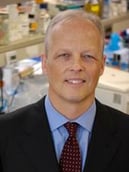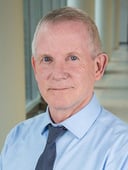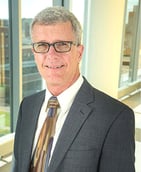Nearly 1,650 people entered three virtual meeting rooms, as the weekly event aligned with social-distancing protocol. Organizers say the technical limitations prevented many more interested people from joining.
“COVID-19 has clearly captured our undivided attention, and it represents the medical challenge of our lifetime,” Chair of Medicine David Schwartz, MD, said during introductions.
“COVID-19: Challenges, Opportunities and Unknowns,” featured key University of Colorado Anschutz Medical Campus experts: Jonathan Samet, MD, MS, dean of the Colorado School of Public Health; Eric Poeschla, MD, head of the Division of Infectious Diseases; and Steven Johnson, MD, and Thomas Campbell, MD, professors in the Division of Infectious Diseases.
Campbell underscored the unknowns of the novel coronavirus and the path that lies ahead.
“Our tools are limited,” he said of the worldwide pandemic that struck just four months ago. “Because of that, we have to learn as we go and adapt our approaches as we go. It’s very important that we keep an open mind in how we approach treatment.”
Campbell also emphasized that what he and his colleagues shared during the hour could change, quickly. “What I say today may likely be out of date next week. This is a rapidly evolving field.”
Jonathan Samet
Here are a few presentation highlights:
Samet: epidemiology and modeling
- The United States now leads in confirmed cases. Hot spots include New York and Detroit.
- In Colorado, cases have well surpassed 3,000. Hot spots include the Denver metro area and Eagle County, probably because of the influx of skiers from all over the world.
- Many of his colleagues have been working (nearly 24/7) on mathematical epidemic models essential to charting the future course of the pandemic and high-level planning.
- Social distancing is critical in terms of reducing the risk of infection and in aiding the healthcare system in meeting critical care needs without exceeding capacity.
- One consequence of social distancing to keep in mind: “If we were to flatten out the curve for a long time, in the end, we would have a large group of susceptible individuals when restrictions are lightened.”
Poeschla: origin and virology
Eric Poeschla
- SARS-CoV-2 is the seventh coronavirus known to infect humans, with the first four largely causing mild symptoms.
- SARS-Cov (the 2003 virus), MERS and the current pandemic virus transitioned into humans from bats. As with the first two of these viruses, an intermediate mammalian host may have been involved with SARS-CoV-2, but it is still unclear whether that is the case or whether the wild animal markets were where it started.
- Why bats? Numerous factors have been proposed, including that they (1) are the only mammals with powered flight; (2) are immensely abundant, widespread and diverse; (3) are highly colonial (large, dense roosts); (4) are very long-lived; and (5) have unusual immune system properties.
- The genome and lifecycle of SARS-CoV-2 have interesting emerging features, including: (1) entry via the ACE2 receptor (the host enzyme that activates the envelope protein); (2) how the virus hides itself inside cells; (3) how it copies its genome; (4) relative deficits in immune responses: (5) its induction of hyperinflammation.
Johnson: clinical care
Steven Johnson
- COVID-19 is an acute lower respiratory infection.
- Typical symptoms include fever, fatigue, cough, muscle pain and shortness of breath.
- Symptoms, however, vary widely. Some patients have presented with headache, sore throat, inflammation of the eyes, loss of taste, loss of smell, nausea and diarrhea.
- Lung X-ray presentations also vary widely.
- Testing can detect the virus in people with no symptoms.
- Heart disease and diabetes seem to be top comorbidities linked with the death rate (but studies are not solid).
- A just-released CDC report found 94 percent of deaths occurred in patients with at least one underlying condition.
- There are many uncertainties, including the impact of pregnancy on outcome, the role of antiviral therapy, and whether infection confers immunity.
Campbell: treatment
- There’s a wide spectrum of COVID-19, from asymptomatic to multiple-organ system failure.
- A correlation appears between inflammation and more serious disease. One of his division’s fellows linked C-Reactive Protein (CRP) results of 100 or more with high rates of intubation.
Thomas Campbell
- “This may be a changing paradigm, but for now we are reserving antivirals for people with moderate to severe infection.”
- Limited studies suggest targeting the hyper-inflammatory response with corticosteroids is worth taking a closer look.
- Other studies, including on the benefit of convalescent plasma infusion, are inconclusive.
- Guidance on using antiviral therapy can be found on the UCH The Source site.
- Many clinical trials are launching on campus.
The event ended with a question-and-answer session. Dr. Schwartz said upcoming Medical Grand Rounds would continue to focus on other aspects of COVID-19.








